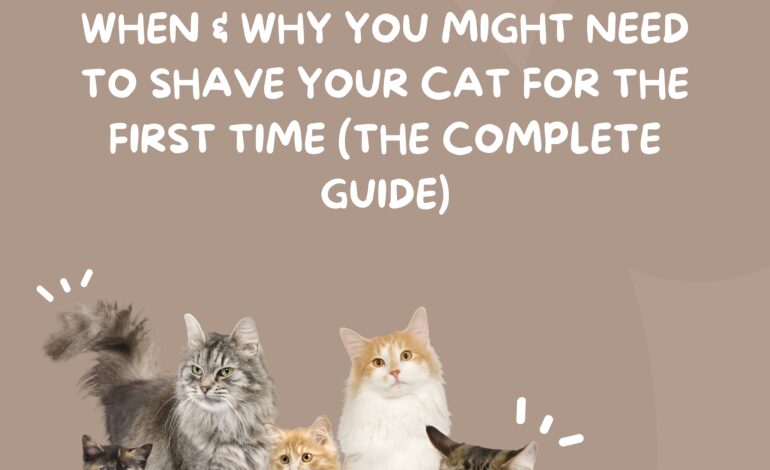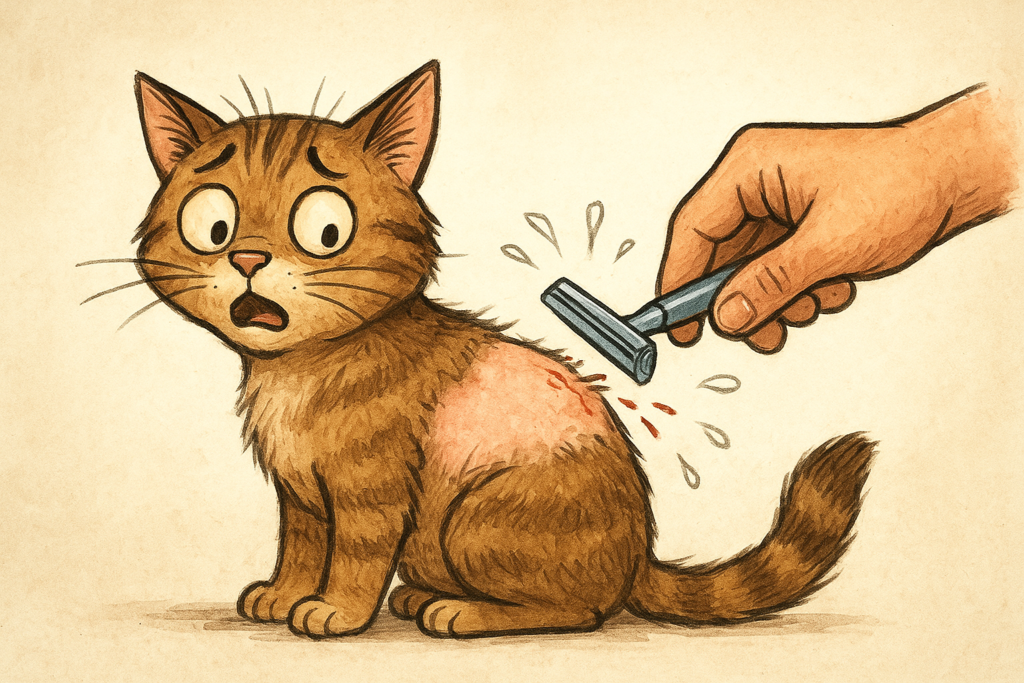When & Why You Might Need to Shave Your Cat for the First Time (The Complete Guide)

Thinking about shaving your cat for the first time? It’s normal to feel nervous — many owners worry about safety, stress, and whether it’s even necessary. Though most cats don’t require full-body shaving, there are some health and hygiene situations (severe, painful matting, before surgery, and heavy soiling in cats that can’t move) where selective shaving done by a trained professional is most humane. Cats’ skin is thin and delicate (generally 0.4 to 2.0 mm depending on location), so there is a risk of nicks and clipper injuries. Long-haired cats are over-represented for coat problems. For example, in a large VetCompass study, 12.7% of Persians had hair coat disorders.(1) So, owners of furry felines need to be especially careful and talk to a vet or professional groomer before shaving.
In this complete guide, we’ll explain when to shave a cat, why it may be needed, and cat shaving tips for beginners to ensure the process is safe and as stress-free as possible.
Do Cats Need Shaving?

Short answer: No — not usually. Cats’ coats serve real biological purposes (insulation, UV protection, sensory function), so routine full-body shaving is generally unnecessary and can cause harm if done without a clear reason.
Exceptions when shaving may be appropriate
- Severe matting that can’t be brushed out – tight mats pull skin, cause sores, and sometimes require sedation and clipping for the cat’s comfort. Professional clipping is the humane option.
- Medical reasons – surgical prep, extensive skin disease (e.g., widespread dermatophyte infection), or topical treatment that needs full skin access. Vets commonly shave in these cases.
- Hygiene in immobile/obese/elderly cats – “sanitary trims” around the rear can prevent soiling and related infections when cats can’t self-groom.
- Severe parasite burdens – when heavy infestations require clear skin visibility for effective treatment, clipping can help (along with medical therapy).
Real risks to weigh before shaving
- Thermoregulation & sunburn – a cat’s coat helps regulate temperature and shield skin; shaving can increase heat stress and UV vulnerability.
- Skin injury & regrowth issues – cat skin is thin (varies ~0.4–2.0 mm by site), so clips risk nicks or follicle damage; some cats develop patchy or slow regrowth.
- Stress– grooming and clipping can be highly stressful; professional handling (or vet sedation for severe cases) reduces risk.
Bottom line
Shaving should be a last resort used only for clear medical, hygiene, or welfare reasons and performed (or approved) by a veterinarian or experienced cat groomer using cat-appropriate equipment and techniques. For most cats, regular brushing, dematting by a pro, and proper care are safer, more effective solutions.
When to Shave a Cat: The Main Reasons

| Reason | When Shaving Is Needed | Key Notes / Stats |
| Medical: Severe Matting | When mats pull skin, cause sores, or can’t be brushed out | Mats may lead to skin infections; humane removal often requires clipping under sedation. |
| Medical: Skin Conditions | Fleas, ringworm, or skin infections where topical treatment is required | Clipping improves treatment access; recommended in veterinary ringworm protocols. |
| Medical: Surgery / Wound Care | Before sterile procedures or wound management | Standard veterinary practice — localized shaving ensures a sterile surgical field. |
| Hygiene: Elderly / Obese Cats | When self-grooming is limited, leading to mats or soiling | Obesity affects >30% of pet cats globally, raising grooming challenges. |
| Hygiene: Long-Haired Breeds | Persians, Maine Coons, etc., prone to tangling & matting | VetCompass: 12.7% of Persians experience coat disorders needing clipping. |
| Myth: Summer Shaving | Owners think it helps cats stay cool | Cat fur regulates temperature & blocks UV; shaving may increase risk of overheating & sunburn. |
Why Shaving Cats Can Be Risky

- Temperature Regulation Disruption
A cat’s fur isn’t just there to look pretty, it’s an insulator because it cools them off during summer and warms them up during winter by filtering airflow and shielding them from extreme temperatures. Fur shaving risks exposing pets to overheating and cold. (2) - Sunburn & Increased Cancer Risk
UV rays are shielded by fur and protective skin. Most likely, sunburn, solar dermatitis, and skin cancer processes affect cats not having fur and are pale or white and soft-coated. (3) - Cuts, Irritation & Skin Infections
Cat skin is thin, shedding fur easily and getting nicked by clippers during the delicate shave. The shave becomes worse when dry, disrupted, or random oil covering patches refuse to the itching, rashes, or infections. - Stress & Anxiety
The process of clipping is unbearably loud, and the action is deeply and uncomfortably invasive; most feline creatures consider this an attack. No, not all cats are the same as those described, because some shave to relieve stress and afterward, they may tend to hide or become skittish. - Regrowth Problems
Fur that has been shaved has the potential of growing back with a different texture and unevenly distributed. The pet cat is not spared, as these uneven and comfortless coats make them suffer.
Cat Shaving Tips for Beginners

Shaving a cat is not the same as trimming dog fur—it requires extra caution due to cats’ thin, elastic skin and their sensitivity to stress. Unless medically necessary or due to severe matting, shaving is rarely recommended. If you must shave your cat at home, here’s what to know.
What You’ll Need
- Quiet pet clippers/trimmers – Choose clippers designed for pets, with a ceramic blade to reduce heat buildup (overheating blades are a major cause of skin burns).
- Brush or comb – Detangling first prevents painful pulls.
- Round-tip scissors – For carefully snipping stubborn mats.
- Towel/blanket & treats – Helps keep your cat calm.
- Optional: a helper – A second person can gently hold and comfort your cat.
💡 Pro tip: Never use human clippers. Pet-specific tools run at safer speeds and are designed for sensitive skin.
Step-by-Step: Shaving Cats for the First Time
| Step | Action | Key Details |
| 1. Prepare your cat | Pick a calm time, trim nails, and brush fur | Best after a meal/play; prevents scratches and makes shaving smoother |
| 2. Introduce clippers slowly | Let cat sniff and hear clippers | Start with clippers off → then on nearby to reduce fear |
| 3. Brush out tangles | Use slicker brush or comb | Smooth fur first; prevents pulling and uneven shaving |
| 4. Shave in fur growth direction | Use slow, steady strokes | Avoid shaving against fur → reduces irritation/razor burn |
| 5. Work in sections | Start with back and sides → then belly/legs | Break grooming into parts to reduce stress |
| 6. Be cautious in sensitive areas | Belly, armpits, tail base, face | Skin is thin and prone to cuts → move carefully |
| 7. Reward your cat | Treats, praise, or playtime | Builds positive association with grooming |
Special Cases
- Matted fur → Don’t pull mats. Instead, slide scissors with a comb underneath the mat for protection before snipping. Only then use clippers.
- Resistant cats → If your cat is aggressive, extremely anxious, or obese (making shaving harder), stop and seek a professional groomer or vet.
Extra Insight:
- Here’s something many cat parents don’t realize: a cat’s skin is about a quarter thinner than a dog’s, so accidental cuts happen more easily.
- And clippers heat up fast — within minutes, they can get hot enough to burn. Always test the blade on your wrist before touching your cat’s skin.
- Studies show stress hormones (cortisol) spike in cats during forced grooming sessions. That’s why short, calm sessions are safer than one long stressful shave.
Post-Shave Cat Care Checklist

| Step | What to Do | Why It Helps |
| 1. Brush regularly | Keep up gentle brushing sessions | Prevents mats and tangles from returning |
| 2. Moisturize if needed | Apply pet-safe moisturizer if skin looks dry | Soothes irritation and prevents flakiness |
| 3. Keep your cat warm | Provide blankets, heated beds, or cozy spots | Shaved cats lose insulation easily |
| 4. Check the skin | Inspect for cuts, redness, or ingrown hairs | Early detection prevents discomfort or infection |
| 5. Give affection & rewards | Offer treats, cuddles, or playtime | Builds positive associations with grooming |
Final Thoughts
Shaving a cat is a last resort. A cat’s coat serves a purpose other than looking nice. It insulates against temperature extremes, helps with sunburn, and protects against skin irritations. If you really must shave a cat, do so slowly, carefully, and with emphasis on the cat’s comfort.
And remember—rule of thumb, if the mats are particularly aggressive, or if you are in doubt of your own skill, a groomer or a vet is the best option. Your cat and you will be relieved by their ability to do it in a safe and calm way. 🐾
👉 Want more step-by-step grooming help? Explore our cat care guides and find the best tools for your kitty at Meow Care Hub.
FAQs About Shaving Cats
Q1: Do cats need shaving?
No. Cats naturally maintain their coats, and shaving is only necessary for specific health or hygiene reasons.
Q2: When should I shave my cat?
Shaving may be needed if your cat has severe matting, skin issues, or struggles to groom due to age or obesity.
Q3: Is shaving safe for cats?
It can be safe if done carefully, but it carries risks. Avoid unless necessary, and consider professional help for full shaves.
Q4: What are the best cat shaving tips for beginners?
Brush before shaving, go with the direction of fur growth, keep sessions short, and always reward your cat afterward.
Q5: Can shaving my cat keep them cool in summer?
No. Fur helps regulate body temperature. Regular brushing is a safer way to keep cats comfortable in warm weather.
Q6: Should I shave my cat at home or see a groomer?
Light trims or small mats may be manageable at home. For full-body shaves, severe mats, or anxious cats, professional grooming is recommended.
Resources:





